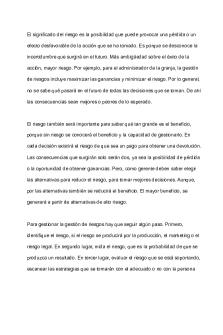Operations, Business Plan, 3. Semester Englisch PDF

| Title | Operations, Business Plan, 3. Semester Englisch |
|---|---|
| Author | Kathrin Yacoub |
| Course | Business in English III |
| Institution | Hochschule Rhein-Main |
| Pages | 3 |
| File Size | 98.7 KB |
| File Type | |
| Total Downloads | 18 |
| Total Views | 148 |
Summary
Wintersemester, 3. Semester BBA,Englisch 3 bei Shanahan...
Description
Operation 1. Variety Vs volume While Gojima offer the same meals every day and a large variety to choose from, we would like to take a different approach to fit in a German market. From 11am to 3pm we will offer more simple sushi burgers and from 5pm to 11pm more extravagant foods that customers can choose from. At lunch time we will have lunch specials at attractive prices to limit the variety on offer. It might be easier to prepare in advance or be quicker to cook and plate. Our lunch customers will spend less time at the restaurant and have as a priority to satisfy their hunger, so a highvolume standard is important. The attractive price encourages customers to choose these items and will be served faster than in a normal fast food restaurant. (standardization) At dinner we will be offering another menu. Our afternoon customers come to spend time and relish the food. The serving volume will be a lot lower than at a fast food restaurant, but we will compensate the loss with a higher set price and the availability to choose individual ingredients. The prices also make it a more exclusive mealtime. Because Gojima serve burgers like no other and only serve high quality food, because they just buy the ingredients from local farmers, customers can not compare the prices and will rank the food as more valuable. To keep this standard and still serve fast we must keep the selection of ingredients small. (customization) 2. Quality control A quality restaurant experience is about more than just serving good food but making the entire dining experience enjoyable as well. So, for example we want to make sure that the volume of our music is audible but not distracting at Gojimas restaurants. Gojima in Sydney doesn´t offer any music at all, so with relaxing music in a German Gojima restaurant, customers would feel much more invited. Employees should regularly check tables and chairs for cleanliness and to ensure they are not wobbly or cracked. It is important that ongoing training is provided for all staff so that consistency in customer service is maintained. Cross-training is an excellent way to ensure quality standards in all areas of the restaurant. Also, we include the two-bite checkback. Thus, we make sure, whether the food pleases the customers or if they are still not satisfied. To meet customer quality standards, we present you another new method. Because we want to know exactly what the customers are not eating, whatever they left on their tables, we photograph the food at the end of what the employees would have to be thrown away afterwards. In hindsight Gojima has the possibility to improve its dishes at the level of customers’ expectations, for example by adding more cheese or maybe less lettuce. Though customers may never see the kitchen, cleanliness and high standards in this area are keys to quality control. We want to be sure food is rotated with each delivery to maintain freshness. Storage temperatures should be checked every day.
3. Capacity Management
To match demand and capacity there are three general strategies, level capacity, chase demand and demand management. Gojima focuses on demand management by using a very simple method, the Restaurant only opens during lunch and dinner time. Thereby our capacity is mostly fully required, and we avoid idle time. Waiters can choose between working 10 hours a day and only work 4 days a week or only work in the evening as a part time job. Cooks must work in shifts. Our opening times are 11am to 3pm and 5pm to 11pm. During the two-hour break at noon, dinner will be prepared. To manage demand throughout the year Gojima must use a different strategy we need to chase demand. Besides the daily restaurant business, we are also offering premises and food for special events, such as birthday parties or different festivities. These will be booked especially during summer and the demand will decrease in autumn and winter. To level the capacity, we can hire seasonal workers, which is a common practice in the service industry or limiting variety. When the rooms are unneeded, they will be closed. In opposite to the restaurant meals, the food for events will be prepared much earlier, when the capacities are free, in order to serve a mass of people at the same time. Furthermore, we must discuss how much capacity we will provide in general. Gojima provides a big store with seats for groups and single tables. We intend to keep this ambience at lunch time but not for dinner. As mentioned before, we want to offer our afternoon customers a more exclusive mealtime. A very high-quality restaurant with an exclusive kitchen. That's why 1/4 of the room will be closed. If there will be a queue in front of the restaurant Gojima increase in popularity. This will also be one of the reasons why customers view Gojima with an exclusive restaurant instead of a fast food restaurant. Because burgers are associated with fast food in general. At the same time, we can also vary the number of seats. If there are too few customers, we reduce the space even more. If the queue is too large and customers become impatient, we will open more seating capacity for them. 4. mix of production methods In Gojima you get your sushi burger by to make to order principle. We intend to keep the make to order method during dinner time because we will make it a more exclusive mealtime and customers will have the opportunity to choose individual ingredients. The associated reduction in volume and revenue more than offsets the higher prices that we will provide for sushi burgers that are custom made. However, we feel that this has a negative effect on the volume we can produce during lunch peak time. At lunch times we want to introduce premade sushi burgers into our production mix. We will use a batch production system for the most popular burgers based on the last weeks point of sale data. This can be produced on-site outside of peak hours using a batch production system. We can ensure consistent quality by standardizing both, work process how the cooks make the sushi burgers and outputs, how the burgers will look. The lower costs of production of these premade burgers will be reflected in the price. The attractive lower price encourages customers to choose these items. Our market research shows that customers associate prepacked food with lower quality, so we have developed high-quality packaging to tackle this issue and guaranteed that it was made fresh that day on site. On entering during peak hours, the customer can choose his production method. If speed and cost are more important, he will enter the queue for premade sushi burgers. If the customers are willing
to accept the wait and the higher price they can select the Make to other method and enter the queue for this production method....
Similar Free PDFs

3 Semester Plan Finance BBA
- 5 Pages

CUE- Business-PLAN - Business plan
- 10 Pages

Business-Plan - Business plan Enc
- 48 Pages

Chapter 3 - Business Plan Report
- 3 Pages
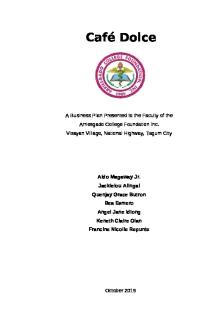
Business Plan
- 26 Pages

Business PLAN
- 3 Pages
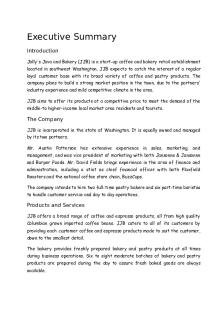
Business PLAN
- 21 Pages
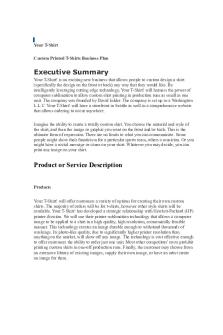
Business PLAN
- 10 Pages

BUSINESS PLAN
- 24 Pages
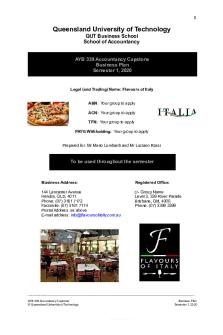
Business Plan
- 28 Pages
Popular Institutions
- Tinajero National High School - Annex
- Politeknik Caltex Riau
- Yokohama City University
- SGT University
- University of Al-Qadisiyah
- Divine Word College of Vigan
- Techniek College Rotterdam
- Universidade de Santiago
- Universiti Teknologi MARA Cawangan Johor Kampus Pasir Gudang
- Poltekkes Kemenkes Yogyakarta
- Baguio City National High School
- Colegio san marcos
- preparatoria uno
- Centro de Bachillerato Tecnológico Industrial y de Servicios No. 107
- Dalian Maritime University
- Quang Trung Secondary School
- Colegio Tecnológico en Informática
- Corporación Regional de Educación Superior
- Grupo CEDVA
- Dar Al Uloom University
- Centro de Estudios Preuniversitarios de la Universidad Nacional de Ingeniería
- 上智大学
- Aakash International School, Nuna Majara
- San Felipe Neri Catholic School
- Kang Chiao International School - New Taipei City
- Misamis Occidental National High School
- Institución Educativa Escuela Normal Juan Ladrilleros
- Kolehiyo ng Pantukan
- Batanes State College
- Instituto Continental
- Sekolah Menengah Kejuruan Kesehatan Kaltara (Tarakan)
- Colegio de La Inmaculada Concepcion - Cebu



